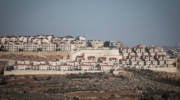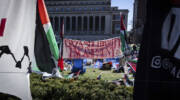
One of Israel’s earliest settlements is where the ancient art of wine-making was revitalized in the 19th century.
It’s picture-postcard perfect: Zichron Ya’akov (“Jacob’s Memorial”), an Israeli town at the southern end of the Carmel mountain range 22 miles south of Haifa, overlooking the Mediterranean Sea and boasting ideal conditions for growing wine grapes.
Dotted with bed-and-breakfasts and an increasing number of hotels and activities for visitors, Zichron is one of the country’s premier destinations for wine- and nature-lovers as well as Israeli history buffs.
One of the first Jewish villages in what was then Ottoman-ruled Palestine, Tzammarin – as it was originally known — was settled by 100 Romanian immigrants in December 1882. Unfortunately, as the headstones in the Zichron Ya’akov cemetery attest, many of these unprepared European newcomers met an untimely death from an outbreak of malaria, many others left, and the survivors discovered just how difficult it was to farm in the rocky terrain.
So the French patron Baron Edmond James de Rothschild stepped in to help, as he did in other early Jewish settlements, and named the town in memory of his father, James (Jacob/Ya’akov in Hebrew).
“He gave them money to continue when they weren’t able to establish the settlement on their own,” says tour guide Esti Herskowitz, “and he figured, ‘If I’m going to be giving all this money I may as well get to name the place.’”
The First Aliyah Museum, housed in what used to be the offices of Rothschild’s employees, offers seven multimedia presentations relating the story of the European immigrants who came to Israel — in particular Zichron Ya’akov — starting in 1882, and how they struggled to get by in the face of illness and poverty.
Cradle of Israel’s wine industry
Rothschild, owner of the famous Chateau Lafite winery, sent over cuttings of French grapevines when it became clear that Zichron was prime wine country where vintners had labored thousands of years earlier.
Rothschild hired professional planners who designed a main street (“midrahov”) with French-style housing, long interior courtyards and rear buildings for agricultural equipment, with the grand Ohel Ya’akov synagogue (again named for James) at its northern tip.
This house of worship, similar to another built by Rothschild farther northeast in Rosh Pina, is still in use and is considered one of the ten most beautiful synagogues in Israel.
The midrahov (pedestrian street), whose official name is Hameyasdim (Founders) Street, is the heart of Zichron today, with many of the original renovated buildings framing a bustling retail area with cafés, galleries and small shops offering everything from handcrafted jewelry to handcrafted wooden toys.
“You can fall in love with Zichron while exploring all the funky shops and café bistros,” Herskowitz says. One of her recommended stops on the main drag is the Tut Neyar (“paper mulberry”) natural paper-making mill and workshop. You can book workshops and demonstrations in advance.
On the strip are also an assortment of bistros and restaurants offering Israeli, Italian, Chinese, French and vegetarian fare. One of the more unusual ones, the Kashtunyo Wine Cellar, is an eight-table restaurant housed in an old underground wine cellar. It features vintages from Israel, Italy, Australia, California, France, and South Africa, and serves Mediterranean dishes such as cheese and stuffed grape leaves.
In 2008, the municipality began further developing the midrahov leading down toward the Carmel-Mizrahi Winery.
If at first you don’t succeed…
Carmel-Mizrahi is a story of persistence if ever there was one. It was established by the baron in 1885 as Israel’s first winery. The venture seemed to be going well until 1892, when the grapevines were decimated by a bacterial disease. Rothschild’s people managed to get hold of some American grape seedlings that were resistant to this bacteria, and things started looking up.
“That was the beginning of Carmel Winery, which is interesting because it’s an old building with brand-new equipment,” says Herskowitz. “In the winery there’s a shop and a restaurant with amazing food in a quaint setting. They recently redid the place so you get the full Carmel Winery experience.”
She’s referring to Carmel Wine & Culture, a complex that includes a wine shop, restaurant, two specialist tasting rooms, a small cinema and barrel room in one of Rothschild’s historic underground cellars.
Here you can see winemaking and book “tutored tastings” on both a large and small scale because, although Carmel is the largest winery in Israel, turning out 15 million bottles per year at four separate facilities, the Zichron branch also has a small state-of-the-art facility for making more expensive wines. Several of these have won prestigious international awards.
“The story of Carmel symbolizes the story of Israel,” says Adam Montefiore, Carmel’s wine development director. “It is the oldest brand and the first exporter of Israeli wine. The first electricity and the first telephone ever installed in Israel were at Carmel. Three prime ministers have worked here: David Ben-Gurion, Levi Eshkol and Ehud Olmert – for Olmert it was a holiday job.”
Though Carmel is the oldest and largest winery in the area, it’s hardly the only one.
The history of Tishbi Estate Winery, in neighboring Binyamina, goes back as far as Carmel’s. In 1882, Rothschild tapped Michael Chamiletzki to plant and develop the vineyards of Zichron (the family surname was changed to Tishbi in 1925 by the poet Chaim Nachman Bialik, but that’s a different story).
Michael’s descendant Jonathan Tishbi now heads the winery, and reports that he can still remember harvesting by hand and bringing the wagons of grapes to be pressed in the winery.
The Smadar Winery, a small boutique winery right off the midrahov, was established in 1998 by Moty Shapira, a fourth-generation vintner and descendant of town founders. Smadar, which has a boutique hotel on the premises, produces red dry wines made from the family vineyards and offers tours, and tastings.
Zichron is also home to a microbrewery called Pavo (“peacock” in Latin).
The Aaronson spy story
In 1915, a noted Zichron botanist named Aaron Aaronson rebelled against the oppressive Turkish Ottoman rulers of Palestine by co-founding NILI, an underground group that supplied intelligence to British military leaders interested in overthrowing the Turks. He was joined by his assistant Avshalom Feinberg and his sisters, among others. In 1917, the Turks, capturing one of Sarah Aaronson’s carrier pigeons, broke NILI’s code and arrested and tortured her. She committed suicide four days later without divulging any information to her interrogators.
The other members of NILI met similarly tragic fates: Aaron was killed in a plane crash on his way to the Paris Peace Conference at the end of World War I. Avshalom was killed by Bedouins in the Sinai as he traveled to meet secretly with British commanders stationed there. Two other NILI members were executed by the Ottomans.
The family home on the midrahov, the Aaronson House, is now a museum with multimedia presentations, sculptures and photographs about life in early Zichron, the Aaronson family and NILI. In the yard you can still see some of the mulberry bushes planted in the 1900s to feed silkworms. Rothschild had hoped to foster a silk manufacturing base here and in Rosh Pina, but it didn’t work out.
“Across the courtyard from Aaron’s house is where Sarah Aaronson’s story unfolds,” says Herskowitz, who likens the storyline to a soap opera. This is where the British spy, a young newlywed, shot herself during a brief stop at home while being transferred from one Turkish prison to another.
Herskowitz cautions that Aaronson House is so popular it’s important to book reservations well in advance.
Making filters and liqueur
Of course, the British did eventually come to power, and the town began to flourish. In 1935, there were 1,650 inhabitants in Zichron Ya’akov. In 1951, three years after the founding of the state of Israel, the population had grown to 4,200. Today it is home to about 19,000 people including a growing number of North American émigrés.
One of Zichron’s prettiest attractions is Ramat Hanadiv, a botanical garden where Rothschild and his family are buried. It has well-tended walkways and playgrounds.
Herskowitz recommends booking a tour at an air-conditioner filter factory at Zichron’s entrance. Though that may not sound exciting, there is more to it than filters; it is one of seven enterprises run by an unusual group of German Christians who live on their own kibbutz in Zichron, founded in 1963. “On the bottom level, Bertha makes jams and sauces that you can buy, and they now opened a little restaurant as well,” says Herskowitz.
In the Zichron region are many other attractions. Yokneam houses the decade-old Morad Winery, which offers tours demonstrating how it turns fruits, vegetables and herbs into exotic wines and liqueurs.
The Israel Salt Company, Israel’s major producer of salt since 1922, is based in nearby Atlit, and it offers tours too. In the 1990s, the company began raising various species of saltwater fish for fish-raising farms in Israel and abroad.
Atlit is also the site of a restored British detention camp that functioned as a temporary holding facility for thousands of illegal Jewish immigrants from 1939 to1948. Afterward, the 25-acre camp became an absorption center for many Jews arriving in Israel from all over the world. Visitors can view a model of the original camp; restored barracks; the main reception facility where new immigrants had to remove their clothes for disinfection; a memorial to those who died en route; and a computerized information database containing information about all the immigrants and ships that set out for the shores of Israel.
By Avigayil Kadesh
Do You Love Israel? Make a Donation - Show Your Support!
Donate to vital charities that help protect Israeli citizens and inspire millions around the world to support Israel too!
Now more than ever, Israel needs your help to fight and win the war -- including on the battlefield of public opinion.
Antisemitism, anti-Israel bias and boycotts are out of control. Israel's enemies are inciting terror and violence against innocent Israelis and Jews around the world. Help us fight back!






















